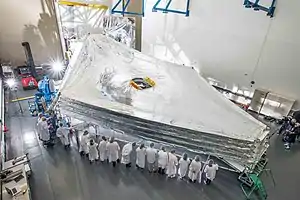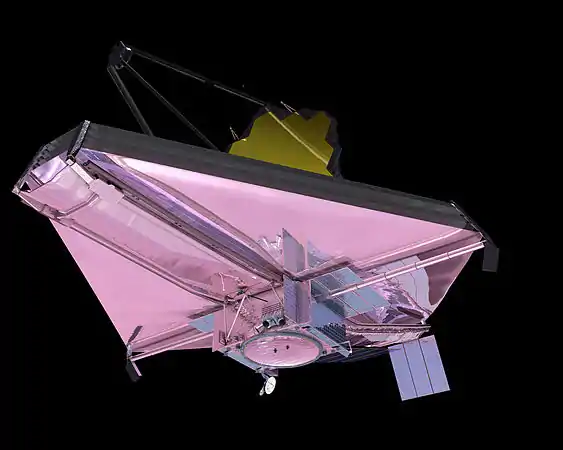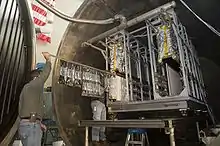Sunshield (JWST)
Sunshield is a component of the James Webb Space Telescope, designed to shield the main optics from the Sun's heat and light. This is part of a space telescope and it extends out unfolding a large metal-coated sheet of material post-launch. This material blocks the Sun's light and heat, so the telescope can see the faint light coming from stars and galaxies. The sunshield segment includes the layers and its deployment mechanisms, which also includes the trim flap.[1][2]



.jpg.webp)
The layers of the sunshield provide an insulating layer for the optics and help dissipate heat. The shield has five layers and, each layer is roughly the size of a tennis court. Each layer is as thin as a human hair and is coated with aluminum for reflectivity. The purple color of some layers comes from the material silicon, the same material in most computer chips, which toughens the shield and which helps it reflect heat. The telescope uses the sunshield to stop itself from being warmed by infrared radiation from the Sun and other nearby planetary objects, which would otherwise inhibit normal operations of onboard instruments.
The purple-magenta hue of the sun-facing side of Sunshield, originates from silicon doped aluminum coating on the outermost kapton membrane.[3]
Overview
The sunshield acts as large parasol allowing the main mirror, optics, and instruments to passively cool to 50 kelvins (−220 °C; −370 °F) or lower.[2] It consists of layers of Kapton and is big enough to shade the main mirror and secondary mirror, leaving only one instrument, the MIRI (Mid-Infrared Instrument), in need of extra cooling.[2] The sunshield has five layers to mitigate the conduction of heat, and the layers also have a special coating to radiate and reflect heat into space.[2] The first layer is 0.002 inches (51 μm) thick, and the other layers are 0.001 inches (25 μm) thick.[4] The kite-shaped sunshield about is 22 meters by 10 meters in size.[5] In operation it will receive about 300 kilowatts of solar radiation, but only pass 23 milliwatts to the other side.[5] It is a V-groove radiator and causes a temperature drop of 300 kelvins (300 °C, 572 °F)[6] from front to back.[5] The telescope needs to be colder than the objects it is attempting to observe.[7] It needs to be cold enough that its internal infrared emissions are significantly less than the observed objects at the relevant wavelengths. The sunshield is a critical part of the telescope to achieve temperatures low enough for the sensitive infrared observations it is planning to make.[7] The sunshield membrane is one of the enabling technologies that will allow the JWST to operate.[8]
To make observations in the near and mid infrared spectrum, the JWST must be kept very cold (under 50 K (−220 °C; −370 °F)), otherwise infrared radiation from the telescope itself would overwhelm its instruments. Therefore, it uses a large sunshield to block light and heat from the Sun, Earth, and Moon, and its position near the Earth–Sun L2 point keeps all three bodies on the same side of the spacecraft at all times.[9] Its halo orbit around L2 avoids the shadow of the Earth and Moon, maintaining a constant environment for the sunshield and solar arrays.[10] The sunshield is made of the polyimide film Kapton, which is stable at very low temperatures.[2]
The core material of the sunshield is the material Kapton coated with aluminum, and the two closest layers to the Sun are also doped with silicon.[2] This helps the material survive in space, radiate excess heat, and they are also designed to conduct electricity so a charge does not build up on the layers.[2] The silicon-doped aluminum layer is 50 nanometers (nm) thick.[4] A 100 nm thick aluminum coating is applied to the front and back of all five layers.[4] The core Kapton layer on the first layer is an extra 0.001 inches (25 μm) thick, and the rest are 0.001 inches (25 μm) in thickness.[4]
Kapton is noted for being stable from -269 to 400 Celsius (-452 to plus 752 degrees Fahrenheit).[3] However, in the long term, even in Earth storage conditions, Kapton can eventually degrade; Kapton used on the Skylab Apollo Telescope Mount had degraded after 40 years.[11]
The layers are designed with Thermal Spot Bond (TSB), which helps stop a rip or hole from increasing in size should one occur.[2] There is a grid pattern bonded to each layer at intervals.[2]
Each layer has a slightly different shape and size.[2] The layer (level 5) is the closest to the primary mirror and is the smallest. The layer closest to the Sun is called Layer 1 and is bigger and more curved.[2] The first layer blocks 90% of the heat, and each successive layer blocks more heat, which is vented out the sides.[2][7] The sunshield allows the optics to stay in shadow for pitch angles of +5° to −45° and roll angles of +5° to −5°.[8]
The sunshield is designed to be folded twelve times so it will fit within the Ariane 5 rocket's 4.57 m × 16.19 m shroud. Once deployed at the L2 point, it will unfold to 21.197 m × 14.162 m. The sunshield was hand-assembled at ManTech (NeXolve) in Huntsville, Alabama before it was delivered to Northrop Grumman in Redondo Beach, California for testing.[12] During launch it is wrapped around the Optical Telescope Element and then later is unfolded.[5] The sunshield is planned to be unfolded two days after launch.[13]
Infrared is heat radiation. In order to see the faint glow of infrared heat from distant stars and galaxies, the telescope has to be very cold. If the telescope were heated by sunlight or the warm glow of the Earth, the infrared light emitted by the telescope would outshine its targets, and it wouldn’t be able to see anything.
— NASA Deputy Senior Project Scientist for the Webb Telescope at Goddard, 2008[14]
Deployment
The sunshield component attaches to the main spacecraft, and its booms expand outward spreading out the head shield and separating the layers.[15] During launch the shield is folded up; later, when it is in space, it is carefully unfurled.[15] Sunshield deployment structure/devices include:[16]
- telescoping booms
- stem deployers
- spreader bars
- cable drives
There are two stem deployers inside the telescoping booms.[16] These are special electrical motors that, when operated, extended the telescopic boom, pulling out the folded sunshield.[16] The telescopic booms are called the MBA, or mid-boom assemblies.[17] At the end of each MBA is a spreader bar.
Components:[17]
- Core
- Front and Aft four-bar linkage
- Aft structure assembly
- Momentum Trim Tab (the tab is attached to the aft structure assembly)
- Aft spreader bars (spreads layers in the rear)
- Forward structure assembly
- Forward spreader bars
- Mid-Booms (one on each side)
- Mid-spreader bars (spreads the 5 layers apart)
- Two forward and Two aft Bipod launch lock assemblies
The Bipod launch lock assemblies are where the Sunshield segment connects to the OTE while it is folded up during launch.[17]
There are six spreader bars that expand to separate the layers of the sunshield, which has roughly six sides.[17]
When the sunshield is fully spread open, it is 14.6 meters wide and 21.1 meters long.[17] When the layers are fully open, they are opened wider at the edges which helps reflect heat out.[17]
Trim flap/momentum trim tab
The sunshield segment also includes that trim flap at the end of a sunshield deployment boom.[1] This is also called the momentum trim tab.[17] The trim tab helps balance out solar pressure.[1] The trim tab also manages the effects of the reaction wheels.[1] The reaction wheels are located in the Spacecraft Bus (JWST)
The trim flap reduces the amount of fuel needed, because the spacecraft does not have to balance out the force from solar pressure.[17]
Layers
.jpg.webp)

.jpg.webp)
The layer nearest to Primary mirror, L5 is the only one with a line of sight to it, while the l5 layer closest to the Sun, is the only one that receives direct sunlight.[2] The separation between layers, in the vacuum of space, prevents heat transfer by conduction and aids in radiating heat out of the way.[16]
The silicon-doping is what causes the purple hue of the areas covered with that material.[16]
The layers are designed so the Sun, Earth, and Moon shine on layer 1 almost exclusively, sometimes a tiny portion of layer 2, and on the other side that the telescope elements only see Layer 5 and sometimes a tiny amount of Layer 4.[17]
Layers:[2]
- Layer 1
- 0.05 millimeters (0.002 inches)
- 100 nm (3.93 microinches) aluminum coating (Both sides)
- 50 nanometers (nm) (1.9 microinches) silicon-doped aluminum
- Biggest area layer[2]
- Layer 2
- 0.025 mm (0.001 inches)
- 100 nm (3.93 microinches) aluminum coating (Both sides)
- 50 nanometers (nm) (1.9 microinches) silicon-doped aluminum
- Layer 3
- 0.025 mm (0.001 inches)
- 100 nm (3.93 microinches) aluminum coating (Both sides)
- Layer 4
- 0.025 mm (0.001 inches)
- 100 nm (3.93 microinches) aluminum coating (Both sides)
- Layer 5
- 0.025 mm (0.001 inches)
- 100 nm (3.93 microinches) aluminum coating (Both sides)
- Smallest area layer[2]
During development the Sunshield layer material was tested with heat, cold, radiation, and high-velocity micro impacts.[14]
Events
See also
- James Webb Space Telescope timeline
- Skylab (also used deployed expanding fabric/layer sun-shield in the 1970s)
- Spacecraft thermal control
- New Worlds Mission (also blocks sunlight, but for observing exoplanets obscured by their bright parent star)
- Insulation
- Heat shield
References
- The Webb Update #5 – September 2008.
- "The James Webb Space Telescope".
- "Sunshield Coatings Webb/NASA". jwst.nasa.gov. Retrieved 2019-09-16.
- "The James Webb Space Telescope".
- "Sunshield".
- "JWST sunshield".
- Ferreira, Becky (October 20, 2014). "This Sunshield Will Keep the World's Most Powerful Space Telescope from Frying". Vice.
- "2015 US FRONTIERS OF ENGINEERING : The James Webb Space Telescope -- Session: ENGINEERING THE SEARCH FOR EARTH-LIKE EXOPLANETS Author: Amy Lo, Northrop Grumman Aerospace Systems".
- "The James Webb Space Telescope". nasa.gov. Retrieved 28 August 2016.
- "L2 Orbit". Space Telescope Science Institute. Retrieved 28 August 2016.
- Willey, Scott (December 10, 2015). "Restoring the Apollo Telescope Mount". National Air and Space Museum. Retrieved 2018-07-12.
When we uncrated the spar in September 2014, we discovered that after 40 years the Kapton®—the shiny, crinkly material you can often see on satellites and in this case the black material you can see in our photos—was in really poor condition.
- Morring, Jr., Frank, Sunshield, Aviation Week and Space Technology, December 16, 2013, pp. 48–49.
- "Deployment".
- Gutro, Rob (November 12, 2008). "Super-Tough Sunshield to Fly on the James Webb Space Telescope". NASA.
- "Super-Tough Sunshield to Fly on the James Webb Space Telescope". NASA. Retrieved 2017-01-20.
- "Testing the Fold: The James Webb Space Telescope's Sunshield". NASA. December 3, 2012. Retrieved 2017-01-20.
- Arenberg, J.; Flynn, J.; Cohen, A.; Lynch, R.; Cooper, J. (9 August 2016). MacEwen, Howard A; Fazio, Giovanni G; Lystrup, Makenzie; Batalha, Natalie; Siegler, Nicholas; Tong, Edward C (eds.). "Status of the JWST sunshield and spacecraft" (PDF). Society of Photo-Optical Instrumentation Engineers (SPIE). Space Telescopes and Instrumentation 2016: Optical, Infrared, and Millimeter Wave. 9904: 990405. Bibcode:2016SPIE.9904E..05A. doi:10.1117/12.2234481. S2CID 126299529. Retrieved 28 March 2018.
- Sharkey, Jim (2016-11-02). "Final layer of sunshield completed for NASA's James Webb Space Telescope". SpaceFlight Insider.
- Lewin, Sarah (March 27, 2018). "NASA Delays Launch of James Webb Space Telescope Until 2020". Space.com. Retrieved 28 March 2018.
External links
| Wikimedia Commons has media related to Sunshield (JWST). |
